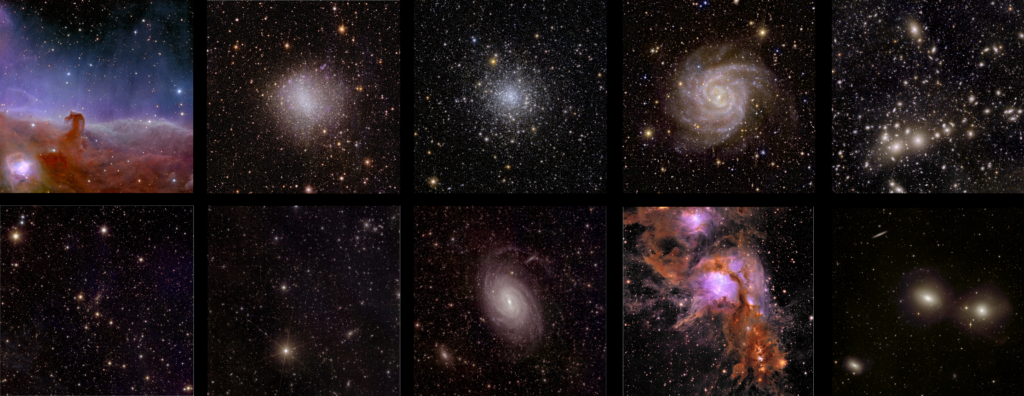Euclid survey operations have only started in February, and tuning the science data pipeline will take several more months. The first results from Euclid’s wide and deep main surveys will take until fall, first cosmology papers at least until late 2025.
However, before Euclid’s surveys started, the special ‘Early Release Observation’ (ERO) programme was initiated by ESA. A call was made to propose astronomical targets and connected science cases to showcase the capabilities of Euclid and its two instruments, VIS and NISP. A selection was done, 17 targets were observed in November and December 2023, and today, May 23rd, 2024, ESA and the Euclid Consortium has published the first ERO science results!

Ten ERO science papers, five additional Euclid reference papers are made public, 513 pages in total. In addition, five more ERO images as well as science data are released by ESA at the same time for the world to use.
Bringing the data into shape outside of the Euclid data pipeline was no small feat, and neither were the scientific studies that analysed the data – with results ranging from free-floating planets to candidates for galaxies in the earliest Universe. More than 1100 authors across the Euclid Consortium, ESA, and industry partners signed the reference papers – celebrating the enormous effort that was sucessfully invested into Euclid over more than a decade. The reference papers will provide background information for use throughout the mission. The ERO science papers are only the beginning of the Euclid era of astronomy and cosmology.
There are explanatory press releases for this event both by ESA as well as by the Euclid Consortium. The ESA press release focusses on the ERO science and access to the new ERO images, while the EC press release also provides more background information on the EC.
Euclid reference papers (link to arXiv):
- Euclid. I. Overview of the Euclid mission, Euclid Collaboration: Mellier et al.
- Euclid. II. The VIS Instrument, Euclid Collaboration: Cropper et al.
- Euclid. III. The NISP Instrument, Euclid Collaboration: Jahnke et al.
- Euclid. IV. The NISP calibration unit, Euclid Collaboration: Hormuth et al.
- Euclid. V. The Flagship galaxy mock catalogue: a comprehensive simulation for the Euclid mission, Euclid Collaboration: Castander et al.
Euclid Early Release Observation science papers (link to arXiv):
- Euclid: Early Release Observations – Programme overview and pipeline for compact- and diffuse-emission photometry, Cuillandre et al.
- Euclid: Early Release Observations – A glance at free-floating new-born planets in the σ Orionis cluster, Martin et al.
- Euclid: Early Release Observations – Unveiling the morphology of two Milky Way globular clusters out to their periphery, Massari et al.
- Euclid: Early Release Observations – Deep anatomy of nearby galaxies, Hunt et al.
- Euclid: Early Release Observations – Globular clusters in the Fornax galaxy cluster, from dwarf galaxies to the intracluster field, Saifollahi et al.
- Euclid: Early Release Observations – Overview of the Perseus cluster and analysis of its luminosity & stellar mass functions, Cuillandre et al.
- Euclid: Early Release Observations – Dwarf galaxies in the Perseus galaxy cluster, Marleau et al.
- Euclid: Early Release Observations – The intracluster light and intracluster globular clusters of the Perseus cluster, Kluge et al.
- Euclid: Early Release Observations – A preview of the Euclid era through a magnifying lens, Atek et al.
- Euclid: Early Release Observations – NISP-only sources and the search for luminous z = 6 – 8 galaxies, Weaver et al.
Accompanying videos:
In addition the Euclid Consortium has created a number of short videos about the publications, just as a short into each paper. Here is the first one, the others will be released over the next hours and days on the Euclid Consortium’s Youtube channel.


